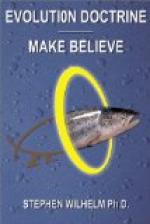Thus the whole process of geological construction is such that older exposed strata continually undergo disintegration, but this involves the destruction of any fossils that they might contain. The very forces that preserve the relics of extinct animals at one time undo their work at a later period. There are many other influences besides that destroy the regularity of rock layers or change their mineralogical characters by metamorphosis. It is easier to see how volcanic outbursts alter their neighboring territory. The intense subterranean heat and imprisoned steam melt the deeper substances of the earth’s crust, so that these materials boil out, as it were, where the pressure is greatest, and where lines of fracture and lesser resistance can be found. Because so much detritus is annually added to the ocean floors—enough to raise the levels of the oceans by inches in a century—it is natural that greater pressures should be exerted in these areas than in the slowly thinning continental regions. These are some of the reasons why volcanoes arise almost invariably along the shores or from the floors of great ocean beds. The chain that extends from Alaska to Chili within the eastern shore of the Pacific Ocean, and the many hundreds of volcanoes of the Pacific Islands bring to the surface vast quantities of eruptive rocks which break up and overlie the sedimentary strata formed regularly in other ways and at other times. The volcanoes of the Java region alone have thrown out at least 100 cubic miles of lava, cinders, and ashes during the last 100 years—twenty times the bulk of the materials discharged into the Gulf of Mexico by the Mississippi River in the same period of time.
From these and similar facts, the naturalist finds how agencies of the present construct new rocks and alter the old; and so in the light of this knowledge, he proceeds with his task of analyzing the remote past, confident that the same natural forces have done the work of constructing the lower geological levels because these earlier products are similar to those being formed to-day. After learning this much, he must immediately undertake to arrange the strata according to their ages. This might seem a difficult or even an impossible task, but the rocks themselves provide him with sure guidance.




